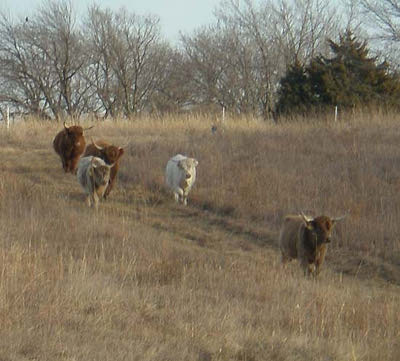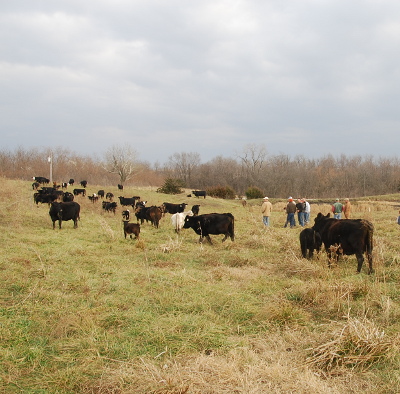
Stockpiling winter forage
 In addition to long
recovery periods and trampling a third of the grass, mob grazing's third unique
feature is stockpiling winter forage.
In addition to long
recovery periods and trampling a third of the grass, mob grazing's third unique
feature is stockpiling winter forage.
Greg Judy notes that 80%
of the expenses for a typical cattle farm come during the winter when
farmers feed hay. You can either make it yourself (which requires
lots of expensive equipment and turns your hayfields into ecological
monocultures), or you can buy hay from your neighbor and at least add
nutrients to your farm (while spending an arm and a leg).
Or you can simply
stockpile your summer grass. Allowing grass to grow tall and
remain standing in the field during late summer means you can keep
grazing your cattle right through the winter without buying much (or
any) hay. Cows also tend to be healthier on stockpiled grass than
on hay --- probably a lot like we feel healthier eating greens out of
our quick hoops all winter rather than subsisting entirely on frozen
produce.
 Although the idea seems best
suited to areas with mild winters, Greg Judy notes that he feeds hay
only about eight days a year on his Missouri farm, and I've read
similar reports from farmers in Ohio and Washington state. Even
when the ground is covered with snow, cows are able to dig up
stockpiled grass (and the grass helps the snow melt faster too.)
Although the idea seems best
suited to areas with mild winters, Greg Judy notes that he feeds hay
only about eight days a year on his Missouri farm, and I've read
similar reports from farmers in Ohio and Washington state. Even
when the ground is covered with snow, cows are able to dig up
stockpiled grass (and the grass helps the snow melt faster too.)
Tomorrow, I'll write
about the nuts and bolts of stockpiling, but I want to back up for a
minute and make sure nobody's getting too carried away. Greg
Judy's operation focuses primarily on beef cattle, with some sheep,
goats, and pigs. Ruminants are going to get a lot more winter
nutrition from stockpile than monogastric animals (like chickens) will
--- don't plan to feed your livestock on stockpiled grass if they
couldn't survive the winter eating hay.
 This post is part of our Mob Grazing lunchtime series.
Read all of the entries: This post is part of our Mob Grazing lunchtime series.
Read all of the entries:
|
Want more in-depth information? Browse through our books.
Or explore more posts by date or by subject.
About us: Anna Hess and Mark Hamilton spent over a decade living self-sufficiently in the mountains of Virginia before moving north to start over from scratch in the foothills of Ohio. They've experimented with permaculture, no-till gardening, trailersteading, home-based microbusinesses and much more, writing about their adventures in both blogs and books.
Want to be notified when new comments are posted on this page? Click on the RSS button after you add a comment to subscribe to the comment feed, or simply check the box beside "email replies to me" while writing your comment.
